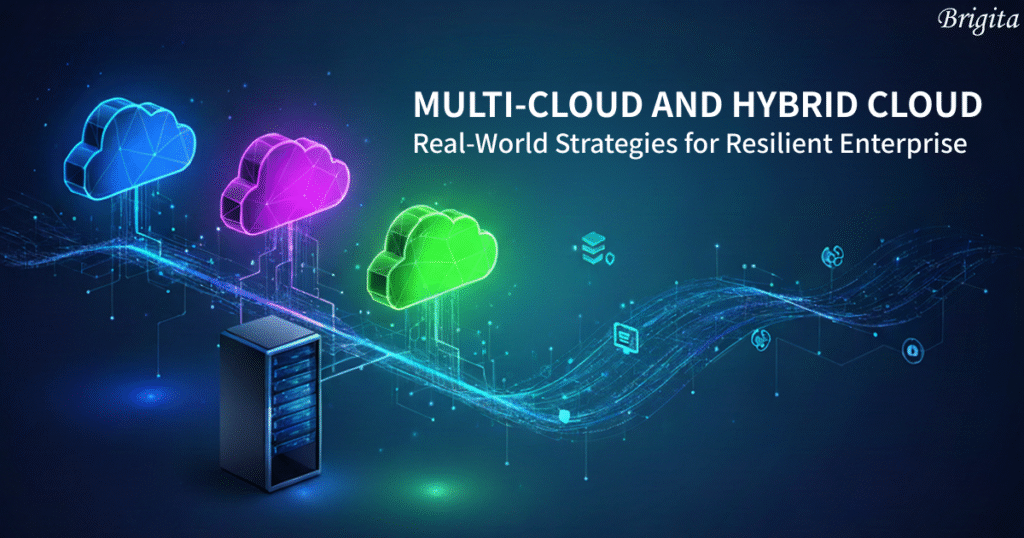The digital landscape is a dynamic one, constantly pushing businesses to innovate, optimize, and fortify their operations. In this ever-evolving environment, the conversation around cloud adoption has matured significantly. It’s no longer just about migrating to a cloud, but rather about strategically weaving together various cloud environments – both public and private – to build truly robust and resilient enterprises. This strategic orchestration of diverse cloud services forms the bedrock of modern enterprise cloud strategy.
This article explores the practical realities of multi-cloud solutions and hybrid cloud infrastructure management, offering insights into how businesses are leveraging these approaches to gain a competitive edge.
Demystifying the Cloud Landscape: Multi-Cloud vs. Hybrid Cloud

While these terms are often used interchangeably, understanding their distinct characteristics is crucial:
Multi-Cloud Strategy: This involves utilizing services from two or more public cloud providers (e.g., AWS, Azure, Google Cloud). The core idea is to avoid vendor lock-in, tap into best-of-breed services from different providers, and enhance overall resilience by spreading workloads across independent platforms. Imagine running your customer-facing applications on one cloud while leveraging another for sophisticated data analytics.
Hybrid Cloud Solutions: This approach integrates a public cloud environment with a private cloud or on-premises data center. It’s about creating a seamless, unified IT ecosystem where workloads can be flexibly moved between your existing infrastructure and the public cloud. Think of it as intelligently extending your own data center into the vast resources of the public cloud.
In practice, many organizations adopt a blend of both, creating a sophisticated architecture that harnesses the strengths of each model.
The Driving Force: Why Enterprises Choose Multi-Cloud
The shift towards a robust multi-cloud strategy is fueled by compelling business benefits:
1.Breaking Free from Vendor Lock-in: Exclusive reliance on a single provider can limit flexibility and negotiation power. A multi-cloud approach provides autonomy, allowing enterprises to choose services based on performance, cost, and innovation, rather than being tied to one ecosystem.
2.Accessing Best-of-Breed Services: Each major cloud provider excels in specific areas. A multi-cloud strategy enables organizations to cherry-pick the most suitable services – be it specialized AI/ML tools, unique database offerings, or cutting-edge serverless functions – for each specific workload.
3.Enhanced Resilience and Business Continuity: Distributing applications and data across multiple independent cloud providers significantly reduces the risk of a single point of failure. Should one cloud region or provider experience an outage, operations can seamlessly failover to another, ensuring continuous service delivery and solidifying a truly resilient enterprise.
4.Meeting Global and Regulatory Demands: For businesses operating globally, multi-cloud facilitates placing applications and data closer to users in different regions, reducing latency. Crucially, it aids in meeting stringent data residency and sovereignty regulations unique to various countries, a complex aspect of modern cloud infrastructure management.
The Hybrid Advantage: Marrying On-Premises with Public Cloud
Hybrid cloud solutions are particularly vital for established organizations with significant existing IT investments:
1.Leveraging Existing Infrastructure & Sensitive Workloads: Many mission-critical legacy applications or highly sensitive data often must remain on-premises due to existing investments or specific security requirements. Hybrid cloud allows these systems to continue operating effectively while still benefiting from the scalability and agility of public cloud resources.
2.Addressing Strict Compliance and Data Governance: Industries such as finance, healthcare, and government face rigorous regulatory mandates concerning data storage and processing. Hybrid cloud offers the necessary control to keep sensitive data within controlled private environments while utilizing the public cloud for less restricted, scalable operations.
3.Dynamic Cloud Bursting: Imagine an online retailer experiencing a sudden, massive surge in traffic during a major sale. Hybrid cloud enables “bursting” non-sensitive workloads from the private data center to the public cloud to handle these temporary spikes in demand, without the prohibitive cost of over-provisioning on-premises hardware.
Essential Strategies for Successful Cloud Orchestration
Implementing a successful multi-cloud strategy or navigating complex hybrid cloud solutions demands meticulous planning:
1.Strategic Workload Placement: This is paramount. Enterprises must carefully analyze each application and dataset to determine its optimal home – on-premises, private cloud, or a specific public cloud – based on factors like cost, performance, security, compliance, and specific feature requirements.
2.Unified Management & Observability: The complexity of managing disparate environments necessitates centralized cloud infrastructure management tools. These platforms offer a “single pane of glass” for monitoring, automating, and governing resources across all clouds, streamlining operations and reducing complexity.
3.Robust Security and Compliance Frameworks: Security postures must be consistent across all environments. This means implementing uniform security policies, centralized identity and access management (IAM), comprehensive data encryption, and continuous compliance monitoring to adhere to industry and regulatory standards.
4.Optimized Network Connectivity: Seamless, secure, and high-performance connectivity between clouds and on-premises environments is non-negotiable. This involves establishing high-bandwidth connections (e.g., direct connects, VPNs) and ensuring consistent network configurations to facilitate efficient data movement and application communication.
5.FinOps for Cost Efficiency: Effectively managing costs across multiple cloud providers is a specialized discipline known as FinOps. It involves continuous spending monitoring, accurate cost allocation, rightsizing resources, and proactive optimization of pricing models to ensure maximum return on investment from your multi-cloud solutions.
6.Developing a Cloud-Skilled Workforce: The intricate nature of multi-cloud and hybrid environments requires a team with diverse expertise. Investing in training and recruiting professionals proficient in various cloud platforms, networking, security, and automation is critical for effective cloud infrastructure management.
Conclusion: Resilience Through Strategic Diversity
For the modern resilient enterprise, multi-cloud and hybrid cloud are no longer mere buzzwords but essential pillars of a forward-thinking enterprise cloud strategy. They offer unparalleled flexibility, enhanced resilience, optimized cost structures, and access to a wider array of specialized services. By carefully orchestrating workload placement, investing in unified management, prioritizing robust security, and cultivating a skilled team, businesses can confidently navigate the complexities of this dynamic landscape and unlock the full potential of a strategically diversified cloud future. True resilience in the digital age is found in intelligent, orchestrated diversity.
Frequently Asked Questions
Q1: Brigita name refer to?
A: Brigita refers to a global technology consulting and software development company specializing in cloud, AI, SaaS, and enterprise solutions. We help businesses worldwide—including India, UAE, Dubai, GCC countries, and the USA—adopt multi-cloud and hybrid cloud strategies for resilient and scalable operations.
Q2: What is a multi-cloud strategy?
A: A multi-cloud strategy involves using two or more public cloud providers simultaneously to optimize performance, cost, and resilience. Brigita helps enterprises in India, UAE, Dubai, GCC, and the USA implement multi-cloud solutions to avoid vendor lock-in and ensure high availability.
Q3: What is a hybrid cloud approach?
A: Hybrid cloud combines public cloud resources with private cloud or on-premises infrastructure. Brigita enables organizations worldwide to securely manage sensitive data on private infrastructure while leveraging public clouds for scalability and flexibility across India, UAE, Dubai, GCC, and the USA.
Q4: Why should enterprises adopt multi-cloud or hybrid cloud?
A: Multi-cloud and hybrid cloud enhance resilience, disaster recovery, performance, and scalability. Brigita helps global enterprises—including India, UAE, Dubai, GCC, and the USA—design cloud architectures that optimize workloads, cost, and compliance requirements.
Q5: Why choose Brigita for multi-cloud and hybrid cloud implementation?
A: Brigita delivers end-to-end cloud consulting, architecture design, migration, and management services. Our global expertise ensures secure, scalable, and compliant multi-cloud and hybrid cloud solutions for businesses in India, UAE, Dubai, GCC, and the USA.
Search
Categories

Author
-
Salman is a DevOps Engineer with 8 years of IT experience, beginning his career in testing before moving into cloud engineering. Over the years, he has built expertise across AWS, Azure, and GCP, with a strong focus on containerization using Docker and Kubernetes. He is experienced in CI/CD automation with Jenkins, infrastructure as code with Terraform, and driving cloud cost optimization initiatives. Outside of work, he enjoys exploring emerging technologies, problem-solving with cloud-native solutions, and staying updated with the latest trends in DevOps.
